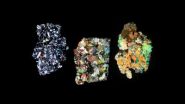CNIO researchers describe a new target for developing anti-angiogenic and anti-tumoral therapies
The results of this study appeared in this month's issue of Blood
2012-05-11
(Press-News.org) Researchers from the Spanish National Cancer Research Centre (CNIO), led by Jorge L. Martínez-Torrecuadrada from the Proteomics Unit, have demonstrated that the antibody-based blocking of ephrinB2, a protein involved in angiogenesis and lymphoangiogenesis, may represent an effective strategy for the development of antiangiogenic and antitumoural therapies.
The results of this study appeared in this month's issue of Blood, the journal of the American Society of Hematology.
CNIO researchers generated highly-specific human antibodies against ephrin-B2 using a phage display approach. These specific antibodies were able to suppress endothelial cell migration and tube formation in in vitro assays. Also, systemic treatment of mice xenografted with pancreatic, lung or colon carcinoma cells resulted in a significant reduction in the amount of blood and lymphatic vessels.
Concomitantly, a drastic inhibition of the tumour growth was observed in every xenograft mouse model used. Therefore, these results validated ephrinB2 as a potential therapeutic target in tumour angiogenesis and lymphangiogenesis and showed that the ephrinB2-specific antibodies developed in this study may be suitable as leads for the development of new improved antiangiogenic therapies, which can be used alone or can complement or synergise with other established antiangiogenic therapies of application in cancer or other angiogenesis-related pathologies.
The angiogenesis process
Angiogenesis is a complex process by which new blood vascular vessels arise from pre-existing ones. In adulthood and under physiological conditions, this process only occurs in some circumstances, such as wound healing or in the menstrual cycle, but it is also an important factor in several pathologies such as cancer, in which the tumour promotes the formation of new blood vessels. This new vasculature provides the tumour with oxygen and nutrients, allowing these cells to grow, invade nearby tissue and eventually metastasise to distant organs.
In addition to blood vasculature, tumour growth induces the development of lymphatic vessels in a similar process called lymphangiogenesis that plays a key role in tissue–fluid homeostasis, as a tissue-drainage system. Recent studies also demonstrated the critical importance of this lymphatic vasculature for the metastatic spread of tumour cells.
In the last decades, the extensive research in the field of tumour-derived angiogenesis led to the identification of several angiogenic targets that can be effectively blocked in order to prevent the formation of new blood vessels in tumours, starving them of oxygen and nutrients and thereby preventing their growth.
As a result of these researches, several antibodies have been successfully developed and have demonstrated clinical utility in treating several tumour types, such as bevacizumab (Avastin®), which is based on the inhibition of vascular endothelial growth factor (VEGF) that promotes endothelial cell proliferation, migration and differentiation.
However, recent emerging experimental and clinical evidence suggests that tumours treated with this antiangiogenic strategy may eventually develop resistance to therapy and exhibit a progression to greater invasiveness. Therefore, there is a pressing need to explore other angiogenic targets that can be used therapeutically, such as the one validated by CNIO researchers in the study now published in Blood.
INFORMATION: END
ELSE PRESS RELEASES FROM THIS DATE:
2012-05-11
A carbon nanotube sponge that can soak up oil in water with unparalleled efficiency has been developed with help from computational simulations performed at the Department of Energy's (DOE's) Oak Ridge National Laboratory.
Carbon nanotubes, which consist of atom-thick sheets of carbon rolled into cylinders, have captured scientific attention in recent decades because of their high strength, potential high conductivity and light weight. But producing nanotubes in bulk for specialized applications was often limited by difficulties in controlling the growth process as well ...
2012-05-11
The report "Sequestration: Health Research at the Breaking Point," released today by Research!America, demonstrates the damaging consequences of potential automatic spending cuts, or sequestration, to the nation's medical research enterprise and public health, and offers examples on how these cuts would delay scientific discoveries that could lead to new treatments and cures for deadly diseases.
This report provides:
The estimated budget cuts to the National Institutes of Health, the Centers for Disease Control and Prevention, the Agency for Healthcare Research and ...
2012-05-11
TEMPE, Ariz. – New findings from NASA's Dawn spacecraft lay the groundwork for the first geological overview of asteroid (4)Vesta and confirm the existence of not one but two giant impact basins in its southern hemisphere. The findings, published today in a set of Science papers, will help scientists better understand the early solar system and processes that occurred as it formed and evolved.
The Dawn spacecraft, orbiting asteroid Vesta since July 2011, has already acquired several thousand images of the asteroid's surface, revealing a complex landscape. The images ...
2012-05-11
MAYWOOD, Ill. – Patients see potential benefits from direct-to-consumer genetic testing, but are also concerned about how test results will be used, and generally are unwilling to pay more than $10 or $20 for them, according to focus groups conducted by researchers at Loyola University Chicago Stritch School of Medicine.
Findings by first author Katherine Wasson, PhD, MPH, and colleagues are published in the American Journal of Bioethics Primary Research. Wasson, an assistant professor in Loyola's Neiswanger Institute for Bioethics and Health Policy, is an expert on the ...
2012-05-11
Seaweeds are important foundational species that are vital both as food and habitat to many aquatic and terrestrial shore organisms. Yet seaweeds that cling to rocky shores are continually at risk of being broken or dislodged from their holds by crashing waves with large hydrodynamic forces. So how do such seaweeds survive in intertidal zones? Do they have special properties that make them extremely flexible or particularly strong?
Patrick Martone (University of British Columbia) has spent a considerable amount of time standing on the shore watching big waves crash ...
2012-05-11
When UCLA's Christopher T. Russell looks at the images of the protoplanet Vesta produced by NASA's Dawn mission, he talks about beauty as much as he talks about science.
"Vesta looks like a little planet. It has a beautiful surface, much more varied and diverse than we expected," said Russell, a professor in UCLA's Department of Earth and Space Sciences and the Dawn mission's principal investigator. "We knew Vesta's surface had some variation in color, but we did not expect the diversity that we see or the clarity of the colors and textures, or their distinct boundaries. ...
2012-05-11
PHILADELPHIA — When the Deepwater Horizon drilling rig exploded April 20, 2010, residents feared that their Gulf of Mexico shores would be inundated with oil. And while many wetland habitats and wildlife were oiled during the three-month leak, the environmental damage to coastal Louisiana was less than many expected, in part because much of the crude never made it to the coast.
Research by a trio of geoscientists, including the University of Pennsylvania's Douglas Jerolmack, now offers an explanation for why some of the oil stayed out at sea. Using publicly available ...
2012-05-11
For the last few decades, space scientists have generally accepted that the bubble of gas and magnetic fields generated by the sun – known as the heliosphere – moves through space, creating three distinct boundary layers that culminate in an outermost bow shock. This shock is similar to the sonic boom created ahead of a supersonic jet. Earth itself certainly has one of these bow shocks on the sunward side of its magnetic environment, as do most other planets and many stars. A collection of new data from NASA's Interstellar Boundary Explorer (IBEX), however, now indicate ...
2012-05-11
Forests in the Amazon Basin are expected to be less vulnerable to wildfires this year, according to the first forecast from a new fire severity model developed by university and NASA researchers.
Fire season across most of the Amazon rain forest typically begins in May, peaks in September and ends in January. The new model, which forecasts the fire season's severity from three to nine months in advance, calls for an average or below-average fire season this year within 10 regions spanning three countries: Bolivia, Brazil and Peru.
"Tests of the model suggested that ...
2012-05-08
GALVESTON, Texas – April 30, 2012 – The proportion of insured girls and young women completing the human papillomavirus (HPV) vaccine among those who initiated the series has dropped significantly – as much as 63 percent – since the vaccine was approved in 2006, according to new research from the University of Texas Medical Branch (UTMB) in Galveston.
The study, published in the current issue of Cancer, reveals the steepest decline in vaccine completion among girls and young women aged nine to 18 – the age group that derives the greatest benefit from the vaccine, which ...
LAST 30 PRESS RELEASES:
[Press-News.org] CNIO researchers describe a new target for developing anti-angiogenic and anti-tumoral therapies
The results of this study appeared in this month's issue of Blood



